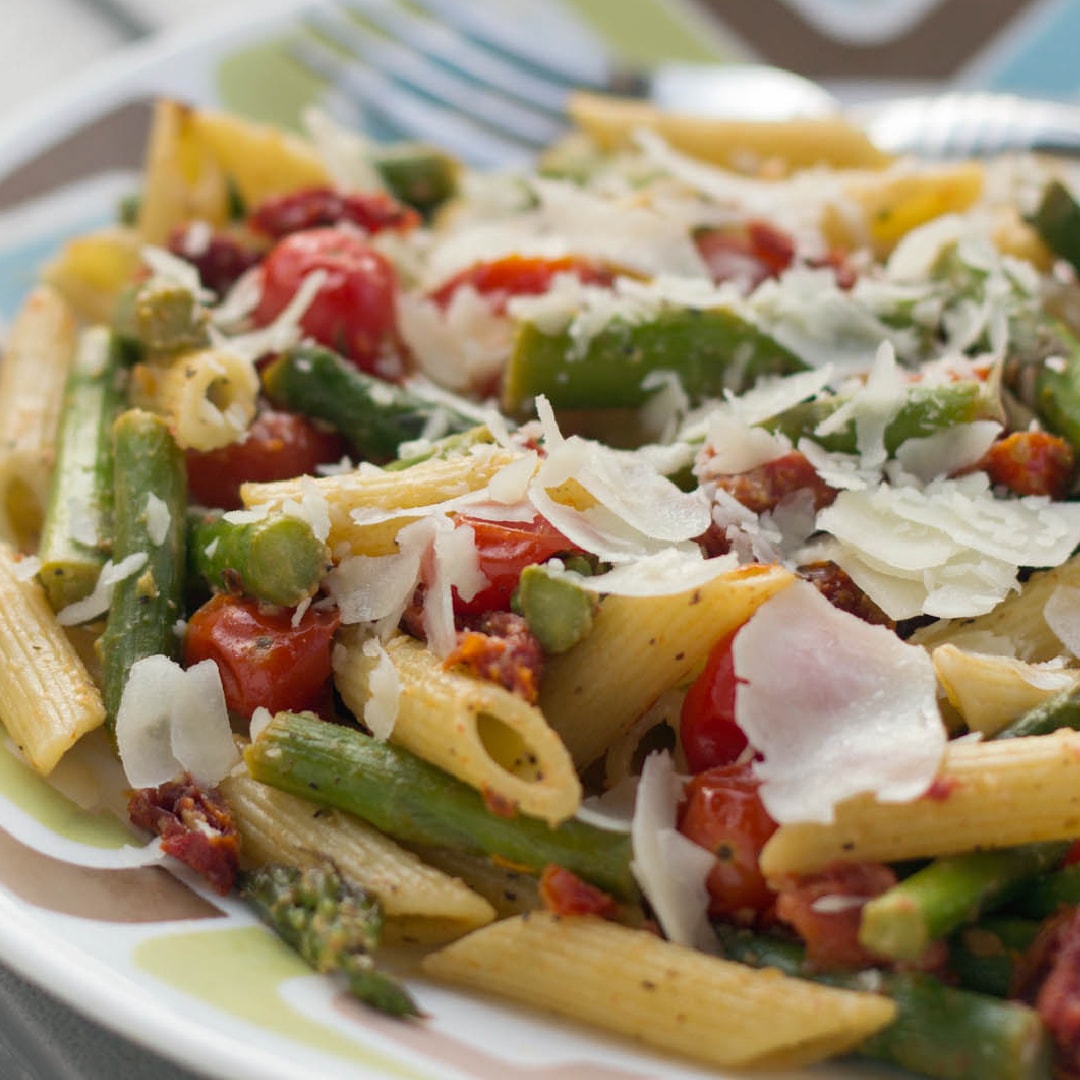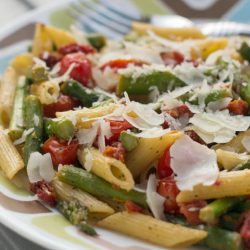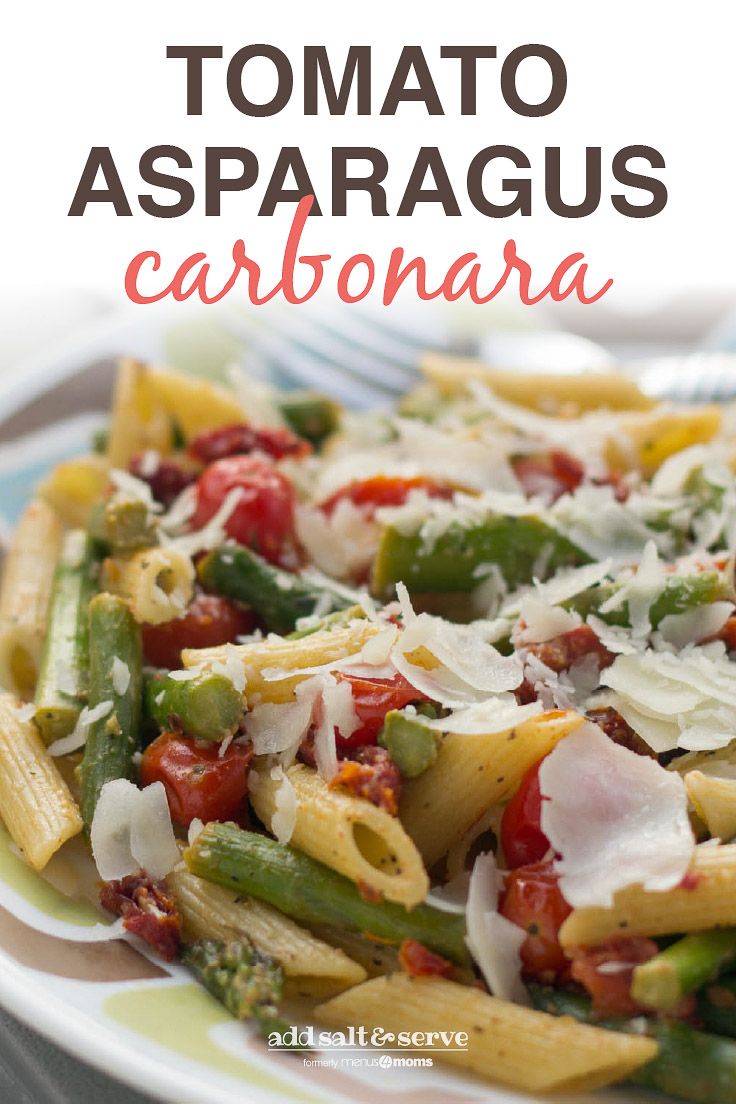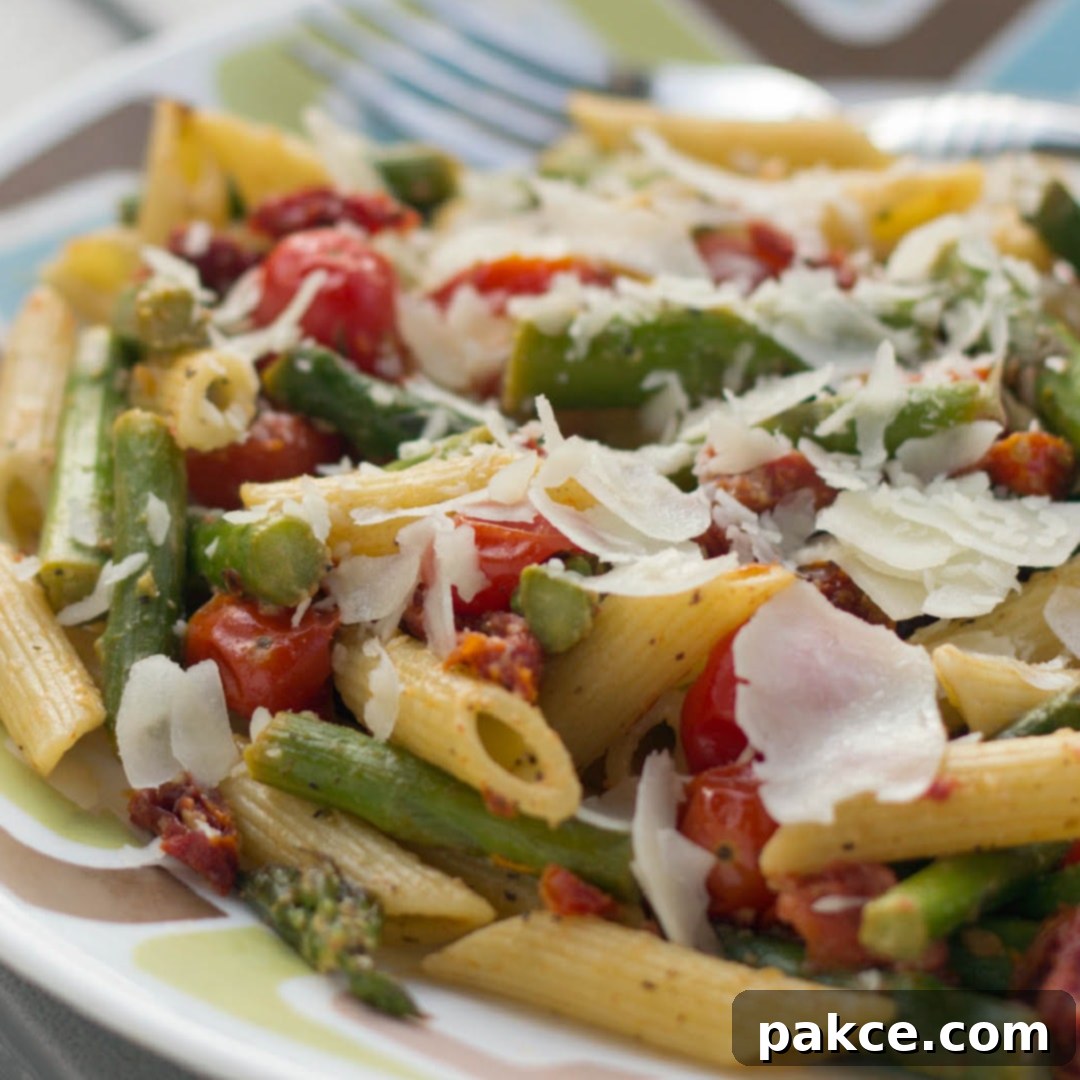Creamy Tomato and Asparagus Carbonara: An Easy, Healthy Summer Pasta Delight
Originating from the heart of Rome, Carbonara is a beloved Italian classic renowned for its luxurious, creamy sauce crafted from simple yet powerful ingredients: eggs, hard cheese, and typically cured pork. Traditionally, the dish uses Pecorino Romano, a sharp, salty sheep’s milk cheese, which lends an unmistakable authentic flavor. In many parts of the world, including the United States, Parmesan cheese often steps in as a readily available and equally delicious alternative, offering a slightly milder, nutty profile. The magic of a true carbonara lies in its preparation: the hot pasta is tossed with raw, beaten eggs and grated cheese, creating a rich, velvety sauce that lightly coats each strand without the need for any added cream.
While the traditional recipe often features guanciale or pancetta for a savory depth, this particular rendition, our delightful Tomato and Asparagus Carbonara, embraces fresh, seasonal vegetables, making it a perfect, lighter option for warmer months or for those seeking a vegetarian-friendly meal. It retains all the satisfying creaminess of a classic carbonara while introducing vibrant flavors and textures from garden-fresh asparagus and juicy tomatoes. Cooking pasta correctly is paramount to any great pasta dish. Always remember to cook your pasta in generously salted water – think of it like the sea. The shorter the cooking time for the pasta, the more heavily seasoned your water should be to infuse flavor directly into the pasta as it cooks.

Recipe

Tomato and Asparagus Carbonara
Add to Shopping ListGo to Shopping List
Ingredients
- 1 tablespoon olive oil
- 1 Lb asparagus, trimmed and cut into 1 inch pieces
- 2 teaspoon garlic, minced
- ¼ teaspoon crushed red pepper flakes, optional
- 1 cup grape tomatoes, cut in half
- ½ cup sun-dried tomatoes packed in oil, drained
- 8 oz. penne pasta
- 1 teaspoon salt, for boiling pasta
- ½ teaspoon salt
- ½ teaspoon pepper
- 1 egg
- ½ cup Parmesan cheese, plus more for garnish
- ¼ cup basil, fresh
Instructions
-
Cook pasta in water with 1 tsp. of salt until al dente. While the pasta cooks, proceed with preparing your vegetables and the egg mixture. Remember to save about 1 cup of starchy pasta water before draining!
-
Heat olive oil in a large skillet or non-stick pan over medium-high heat. Add the trimmed and cut asparagus pieces and sauté for about 3 minutes until they are bright green and slightly tender-crisp.
-
Stir in the minced garlic and crushed red pepper flakes (if using for a hint of heat), cooking for just one more minute until the garlic is fragrant, being careful not to burn it.
-
Reduce the heat to medium. Add all the grape tomatoes (halved) and drained sun-dried tomatoes. Cook for about 6 minutes, or until the grape tomatoes have softened and burst slightly. Stir gently to ensure they cook evenly without being completely crushed.
-
In a separate bowl, whisk together the egg with ½ cup of Parmesan cheese, the remaining ½ teaspoon of salt, and ½ teaspoon of pepper until well combined and slightly frothy. This is your carbonara base.
-
Drain the hot, cooked pasta thoroughly (do not rinse!). Immediately add the hot pasta to the egg mixture, tossing vigorously and quickly. The residual heat from the pasta will gently cook the egg, creating that signature creamy carbonara sauce. If the sauce seems too thick, add a tablespoon or two of the reserved starchy pasta water to achieve your desired consistency.
-
Finally, add the prepared tomato and asparagus mixture to the pasta, tossing gently to combine everything. Continue tossing until the sauce has fully thickened and evenly coats all ingredients. Serve immediately in shallow bowls, garnished with chopped fresh basil and an extra sprinkle of Parmesan cheese. Enjoy!
Notes
- To prepare asparagus, rinse it under running water. To find the natural breaking point of the stalk, hold it with both hands: one hand near the tip, the other closer to the cut end. Gently bend the stalk until it snaps. This ensures you remove the woody, tough part and are left with only the tender portion.
- The key to the creamy carbonara sauce without cream is proper heat management. The heat from adding the egg mixture to the hot pasta will gently cook the egg, thickening it into a light, luscious, creamy sauce. Ensure the pasta is hot but not scorching, and toss continuously to prevent the eggs from scrambling.
- Parmesan garnish is optional and not included in the provided nutritional data. Feel free to add more to taste!
- For an even silkier sauce, consider tempering the egg mixture. Before adding the pasta, slowly whisk a ladleful of hot pasta water into the egg and cheese mixture. This slowly raises the temperature of the eggs, making them less likely to scramble when they hit the hot pasta.
Nutrition per serving
Share
Pin
Why You’ll Love This Tomato and Asparagus Carbonara
This isn’t just another pasta dish; it’s a celebration of fresh, vibrant flavors combined with the comforting richness of a classic Italian technique. Here’s why this Tomato and Asparagus Carbonara will quickly become a favorite in your kitchen:
- Quick & Effortless Weeknight Dinner: With a prep time of just 10 minutes and a cook time of 20, you can have a gourmet-tasting meal on the table in half an hour. It’s the perfect solution for those busy evenings when you crave something special but are short on time.
- Fresh, Seasonal Flavors: Asparagus and grape tomatoes are at their peak in spring and summer, offering crisp textures and sweet, juicy bursts that elevate the dish. Sun-dried tomatoes add a concentrated umami depth, bridging the fresh and savory elements beautifully.
- Creamy Texture, No Heavy Cream Added: True carbonara relies on the emulsification of egg yolks, cheese, and starchy pasta water to create its signature silky sauce. This recipe honors that tradition, delivering a luxurious creaminess that feels indulgent without any added heavy cream, making it lighter and healthier.
- A Versatile Vegetarian Delight: While traditional carbonara features cured pork, this version shines as a hearty and flavorful vegetarian main dish. The robust flavors from garlic, red pepper, and the variety of tomatoes ensure a satisfying experience even without meat. For those who can’t resist a bit of pork, a sprinkle of crispy pancetta or guanciale can easily be added to the sautéed vegetables.
- Nutrient-Rich: Asparagus brings essential vitamins and fiber, while tomatoes offer antioxidants. Combined with protein from the egg and cheese, this pasta is a balanced meal that fuels your body.
Mastering the Ingredients: What You’ll Need for Carbonara Perfection
The beauty of Italian cooking often lies in its simplicity, using high-quality ingredients to create extraordinary flavors. This Tomato and Asparagus Carbonara is no exception. Understanding each component and how it contributes to the dish is key to achieving a truly remarkable result.
The Pasta: Foundation of the Dish
For this recipe, we recommend penne pasta, as its tubular shape and ridges are excellent for catching and holding the creamy sauce and small vegetable pieces. However, feel free to experiment with other short pasta shapes like rigatoni or fusilli, or even classic long strands like spaghetti or bucatini for a more traditional carbonara feel. The most critical aspect is cooking your pasta “al dente” – meaning “to the tooth.” It should be tender yet still firm to the bite, not mushy. This texture is vital for the dish’s overall mouthfeel and allows the pasta to absorb the sauce better. And as mentioned, generously salting your pasta water is non-negotiable; it’s the only chance you get to season the pasta itself from the inside out.
Fresh Asparagus: A Spring & Summer Star
Asparagus is a versatile and healthy vegetable that brightens this carbonara with its distinct, slightly earthy flavor and satisfying crunch. When selecting asparagus, look for firm, bright green stalks with tightly closed tips. Thicker spears tend to be more tender than very thin ones. Proper trimming is essential to remove the woody, fibrous ends. The easiest method is to simply snap the stalk: hold it with both hands, one near the tip and the other near the base, and bend until it naturally breaks. This ensures you’re left with only the most tender part of the vegetable. Asparagus is also packed with vitamins K and A, and folate, adding a healthy boost to your meal.
Sweet Grape and Sun-Dried Tomatoes
This recipe uses two types of tomatoes to create a dynamic flavor profile. Sweet, juicy grape tomatoes burst when cooked, releasing a fresh, vibrant acidity that contrasts beautifully with the richness of the carbonara sauce. Sun-dried tomatoes, packed in oil, bring a concentrated, intense tomato flavor and a chewy texture that adds depth and complexity. Be sure to drain the sun-dried tomatoes before adding them to avoid excess oil in your dish.
The Essential Carbonara Sauce: Eggs & Cheese
The heart of any carbonara is its luscious, creamy sauce, and this vegetarian version is no different. One large egg, combined with freshly grated Parmesan cheese, forms the foundation. While traditionalists might insist on Pecorino Romano, Parmesan offers a milder, saltier, and nuttier flavor that is widely loved and more accessible. When whisked together, the egg and cheese create an emulsifying base that, when introduced to hot pasta, transforms into a silky sauce. The key is to work quickly and continuously toss the pasta to prevent the eggs from scrambling, instead creating a beautiful, uniform coating.
Aromatic Boosters: Garlic, Red Pepper, and Basil
Garlic provides a foundational aromatic note, while a pinch of crushed red pepper flakes adds a subtle warmth and a gentle kick, enhancing the overall flavor without overpowering it. Fresh basil, stirred in at the end and used as a garnish, contributes a fragrant, herbaceous finish that ties all the vibrant flavors together. Don’t skip the fresh basil; it truly makes a difference!
Expert Tips for Carbonara Perfection
Achieving a restaurant-quality carbonara at home, especially one featuring fresh vegetables, is entirely possible with a few key techniques. Follow these expert tips to ensure your Tomato and Asparagus Carbonara turns out perfectly creamy and delicious every time:
- Use Quality Ingredients: Since carbonara is a dish of few ingredients, the quality of each component truly shines through. Opt for fresh asparagus, ripe grape tomatoes, good quality olive oil, and freshly grated Parmesan cheese.
- Salt Your Pasta Water Generously: This can’t be stressed enough! The pasta water should taste like the sea. This is your primary opportunity to season the pasta itself, which is the backbone of the dish.
- Cook Pasta Al Dente: Slightly undercooked pasta will continue to cook when tossed with the hot sauce. Al dente pasta also maintains its structure and provides a satisfying bite.
- Temper the Eggs (Optional but Recommended): For an extra safeguard against scrambled eggs, slowly whisk a tablespoon or two of the hot, starchy pasta water into your egg and cheese mixture before adding it to the drained pasta. This gently raises the temperature of the egg mixture, making it less prone to scrambling when mixed with the very hot pasta.
- Work Quickly and Toss Continuously: The moment the hot pasta hits the egg and cheese mixture, you need to toss vigorously and without interruption. This ensures the heat is evenly distributed, cooking the egg just enough to form a creamy emulsion rather than scrambled bits.
- Reserve Pasta Water: Always reserve at least a cup of starchy pasta water. It’s your secret weapon for achieving the perfect sauce consistency. If your sauce appears too thick or dry, a splash of this liquid will emulsify it into a smooth, creamy texture.
- Serve Immediately: Carbonara is best enjoyed fresh off the stove. The sauce is at its peak creaminess when warm, and the flavors are most vibrant.
Creative Variations to Explore
While this Tomato and Asparagus Carbonara is fantastic as is, don’t hesitate to get creative and customize it to your taste or what you have on hand:
- Add Protein: For a non-vegetarian option, crisp up some pancetta, guanciale, or bacon before sautéing the asparagus, then crumble it back into the dish at the end. Cooked chicken or shrimp would also make excellent additions.
- Other Vegetables: Peas, mushrooms, spinach, or even thinly sliced zucchini could be swapped in or added alongside the asparagus and tomatoes for different flavor profiles.
- Cheese Swaps: Experiment with different hard Italian cheeses. While Parmesan is fantastic, a blend with Pecorino Romano will give a sharper, more piquant flavor.
- Herb Alternatives: If fresh basil isn’t available, fresh parsley or chives can offer a lovely alternative.
Serving Suggestions
This rich and vibrant Tomato and Asparagus Carbonara is satisfying enough to stand on its own, but it also pairs beautifully with a few simple accompaniments. A crisp green salad with a light vinaigrette would provide a refreshing counterpoint to the creamy pasta. A side of crusty artisan bread is perfect for soaking up any leftover sauce. For a complete Italian dining experience, consider starting with a light antipasto platter before diving into this delightful main course.
Pin this recipe:

